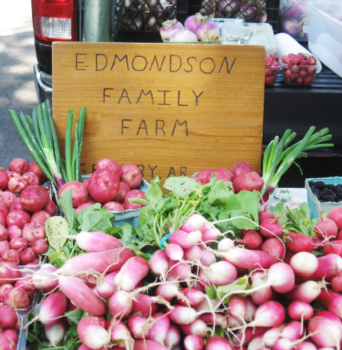Tips for Selling at Farmers Markets
NCAT Marketing Tipsheet Series
By Marisa Alcorta, Rex Dufour and Tammy Hinman, NCAT; Updated by Omar Rodriguez
Farmers markets are temporary retail establishments typically held outdoors, where farmers come to sell their produce at a specified place and time. Farmers markets are growing in popularity across the country and can be a good entry-level selling place for beginning farmers.
For this market you can expect:
- Lower volume of product
- Higher prices per unit
Advantages
- Farmers markets help growers discover local demand for products, and direct contact with customers makes them excellent places to experiment with new and heirloom products.
- You generally have flexibility in the variety and volume of
products you take to market. - No standard pack or grade is required, but your produce should
be good quality. - Farmers markets are a great place to network and see what other farmers are doing, as well as
experiment with new and heirloom products. - You have the opportunity to build a loyal customer base, including local chefs.
Considerations
- Identify market channels on travel routes to and from your market to increase sales and efficiency.
- When setting prices, examine production/administrative costs, profitability goals, market prices, and consumer preferences.
- If you sell at several farmers markets, schedules can be demanding.
- To sell at popular farmers markets, it helps to have unique products.
- Being successful requires positive interactions with the public.
- Most farmers markets have an application process and rules to participate. For example, in California you must register as a “certified grower” with the county agriculture commissioner before selling at a certified farmers market.
Tips for Selling at Farmers Markets
Get creative with your produce display. A good banner and signage with pricing information save time and increase comfort for your customers.
- Consistency is key, both in terms of the product you take to market as well as being there on every scheduled market day.
- Consider providing samples of your product if local regulations permit.
- Set up a service system where customers do not have to wait too long in line.
- Invest in a scale that not only calculates weight but also gives you the sales price. A calculator that prints on a paper tape is another useful tool.
- Visit markets seasonally and speak to market managers to figure out what’s missing from your market
that you could supply. - Understand your customer. In addition to keeping sales records, it is beneficial to define your customer base and their trends (daily and throughout the season).
Key Questions to Ask Yourself
- Do I enjoy working with the public? If not, can I hire someone friendly and competent for my booth?
- Where are the nearest farmers markets? Are they accepting new vendors?
- Do these farmers markets have enough customers to make it profitable for new vendors?
- What are the other vendors selling? What’s my niche?
- How much time will I spend at the market? How early will my day start and end?
- Am I willing to do this each week?
- What is the application process for the farmers market? What are the rules? For example, can I sell products I have not grown?
Resources
- Find a Farmers Market by searching the USDA’s online directory.
- Growing for Market magazine offers the free issue, “Selling at Farmers Markets.”
- Local Harvest is a nationwide directory of small farms, farmers markets, and other local food sources. The site helps consumers buy what they want directly from the farmers and ranchers who produce it.
- Farmers Market Coalition is an organization geared toward the development of farmers markets, and it has many useful resources.
Tips for Selling at Farmers Markets
© 2012 National Center for Appropriate Technology—NCAT
By Marisa Alcorta, Rex Dufour and Tammy Hinman, NCAT
Updated 2018 by Omar Rodriguez
This publication is produced by the National Center for Appropriate Technology through the ATTRA Sustainable Agriculture program, under a cooperative agreement with USDA Rural Development. This publication was also made possible in part by funding from USDA/NIFA/OASDFR. ATTRA.NCAT.ORG.
Related Publications
- Scheduling Vegetable Plantings for Continuous Harvest
- Season Extension Techniques for Market Gardeners
- Tips for Selling at Roadside Stands
- Tips for Selling to Aggregators/Grower Marketing Coops
- Tips for Selling to Institutional Markets
- Tips for Selling to Wholesale Buyers at Terminal Markets
- Tips for Selling to Produce Distributors
- Tips for Selling to Produce Packing Houses
- Tips for Selling with Agritourism and “Pick-Your-Own”


